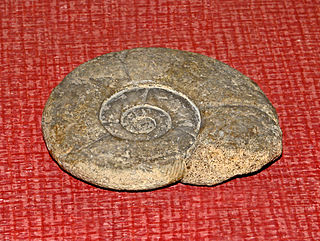
Acanthohoplites is an extinct genus of ammonites in the family Parahoplitidae that lived in the Aptian and Early Albian stages of the Early Cretaceous.
Algericeras is an extinct ammonite genus belonging to the superfamily Acanthoceratoidea that lived during the Cenomanian stage at the beginning of the Late Cretaceous in what is now Mexico.

Ancyloceras is an extinct genus of heteromorph ammonites found throughout the world during the Lower Cretaceous, from the Lower Barremian epoch until the genus extinction during the Lower Aptian.
Neoptychites is an extinct ammonoid cephalopod genus from the Turonian stage of the Upper Cretaceous, with a worldwide distribution.

Mammites is a Late Cretaceous ammonite genus included in the acanthoceratoidean family, Acanthoceratidae, and the type genus for the subfamily Mammitinae. Mammites was named by Laube and Bruder in 1887.

Eubostrychoceras is a genus of helically wound, corkscrew form, heteromorph ammonite which lived during the Upper Cretaceous. The genus is included in the ancycleratid family Nostoceratidae.

Macroscaphites is an extinct cephalopod genus included in the Ammonoidea that lived during the Barremian and Aptian stages of the Early Cretaceous. Its fossils have been found throughout most of Europe and North Africa.

Pachydesmoceras is a genus of ammonites belonging to the family Desmoceratidae.

Calycoceras is an extinct genus of cephalopods belonging to the subclass Ammonoidea and family Acanthoceratidae that lived during the Cenomanian stage of the Late Cretaceous, 100-94 Mya. Their shells had ornate ribs.

Lewesiceras is a genus of large ammonites belonging to the order Ammonitida and the family Pachydiscidae.

Puzosia is a genus of desmoceratid ammonites, and the type genus for the Puzosiinae, which lived during the middle part of the Cretaceous, from early Aptian to Maastrichtian. Sepkoski defines the range from Albian to Santonian. The generic name comes from the Serbian words "Puž" (snail) and "oce/ose" (axis), gaining its name from the shell's snail-like appearance.

Phyllopachyceras is an extinct genus of ammonoid cephalopods belonging to the family Phylloceratidae. These nektonic carnivores lived in the Cretaceous, from Hauterivian to Maastrichtian to age.

Pseudothurmannia is a genus of extinct cephalopods belonging to the subclass Ammonoidea and included in the family Crioceratitidae of the ammonitid superfamily Ancylocerataceae. These fast-moving nektonic carnivores lived in the Cretaceous period, from Hauterivian age to Barremian age.

Kossmaticeras is an extinct ammonoid genus belonging to the desmoceratacean family Kossmaticeratidae. Species in this genus were fast-moving nektonic carnivores. They lived during the Late Cretaceous, from upper Turonian to upper Maastrichtian age. The type species of the genus is Ammonites theobaldianus.

Silesites is an ammonite genus placed in the family Silesitidae. Species in this genus were fast-moving nektonic carnivores. They lived during the Cretaceous, in the Barremian age. The type species of the genus is Silesites seranonis .

Dufrenoyia is an extinct genus of Cretaceous ammonites included in the family Parahoplitidae. These fast-moving nektonic carnivores lived in the Cretaceous period. The type species of the genus is Ammonites dufrenoyi.

Vascoceras is an extinct genus of Cretaceous ammonites included in the family Vascoceratidae. These fast-moving nektonic carnivores lived in the Cretaceous period from the late Cenomanian to the early Turonian. The type species of the genus is Vascoceras gamai from Portugal.

Sonneratia is an extinct genus of Cretaceous ammonites included in the family Hoplitidae. These fast-moving nektonic carnivores lived in the Cretaceous period, Aptian - Albian age.

Gaudryceras is an ammonite genus belonging to the family Gaudryceratidae.

Eotetragonites is an extinct genus of ammonite.


















